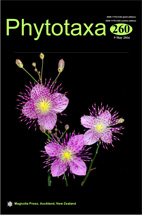Abstract
Vanda funingensis, a new orchid species from Yunnan, China, is described and illustrated here. This species, which has thin, regular tepals, a slender spur, and a relatively dense inflorescence, is superficially similar to species of Vanda s.l. with Ascocentrum-like flowers. However, the plant differs from the latter by having labellum structures shared by Vanda s.s., longitudinal ridges on the adaxial surface and no expansion of the spur apex. Furthermore, molecular phylogenetic analyses indicate that the new species is a member of sect. Testacea from Vanda s.s., especially V. coerulescens (in the nrITS analysis) and V. testacea. This new species is distinguished from the other two species by having flat petals, a rectangular midlobe with three inconspicuous ridges adaxially and a long, tubular spur.

